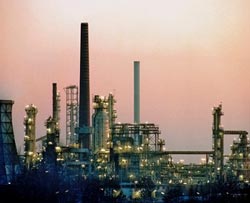Network Stability through Automatic Load Shedding

Siemens has developed an automatic load shedding system for the power supply of large-scale industrial plants in the oil and gas industry, helping to stabilize the networks in critical situations.<br>
With an automatic load shedding technology – in other words a regulated interruption of power to consumers – the balance in a power grid can be maintained.
This solution is intended primarily for use in the oil and gas industries, whose drilling and production facilities are often equipped with their own power plants and grids. As in every power grid, island-capable networks must also be able to maintain a constant balance between the generation and the consumption of electricity.
If the balance is disturbed – for example, if a large consumer shuts down because of a failure – the whole network can collapse in a worst case scenario. An interruption of only an hour at a large refinery or an LPG facility can already cause millions of euros in costs. Automatic load shedding prevents shutdowns by disconnecting consumers according to specific priorities until the grid obtains a level at which it can remain stable.
Until now, when a disruption occurred – for example, if the network frequency dropped – load shedding systems have shut down pre-determined consumers. Sometimes, this meant that too much load was shed, and the network remained out of balance.
Other units of equipment would then fail, leading to a complete shut down. For automatic load shedding, all of the possible disruption patterns are worked out ahead. The aim is to determine which consumers need to be disconnected in order to keep the grid stable. The highest priority is to keep production running smoothly.
In other words, air conditioners, lighting, and other non-critical devices are the first to be taken offline. When a disruption occurs, the load shedding system recognizes which scenario it is dealing with based on data from the grid and shuts down the appropriate consumers in less than a tenth of a second.
Short reaction times are achieved using glass-fiber Ethernet and GOOSE-Telegramme – special communication services that enable rapid communication across the entire network. As a prerequisite, the system had to be designed according to the IEC 61850 communication standard for energy systems. This rapid shutdown is supported by dynamic load shedding in which the system determines performance reserves.
As a reserve function, additional frequency-dependent load shedding ensures the highest level of operational security. Because the new load shedding technology is based on the Siemens control system for energy systems, installation does not result in costs for additional equipment.
Media Contact
More Information:
http://www.siemens.com/innovationnewsAll latest news from the category: Power and Electrical Engineering
This topic covers issues related to energy generation, conversion, transportation and consumption and how the industry is addressing the challenge of energy efficiency in general.
innovations-report provides in-depth and informative reports and articles on subjects ranging from wind energy, fuel cell technology, solar energy, geothermal energy, petroleum, gas, nuclear engineering, alternative energy and energy efficiency to fusion, hydrogen and superconductor technologies.
Newest articles

High-energy-density aqueous battery based on halogen multi-electron transfer
Traditional non-aqueous lithium-ion batteries have a high energy density, but their safety is compromised due to the flammable organic electrolytes they utilize. Aqueous batteries use water as the solvent for…

First-ever combined heart pump and pig kidney transplant
…gives new hope to patient with terminal illness. Surgeons at NYU Langone Health performed the first-ever combined mechanical heart pump and gene-edited pig kidney transplant surgery in a 54-year-old woman…

Biophysics: Testing how well biomarkers work
LMU researchers have developed a method to determine how reliably target proteins can be labeled using super-resolution fluorescence microscopy. Modern microscopy techniques make it possible to examine the inner workings…





















